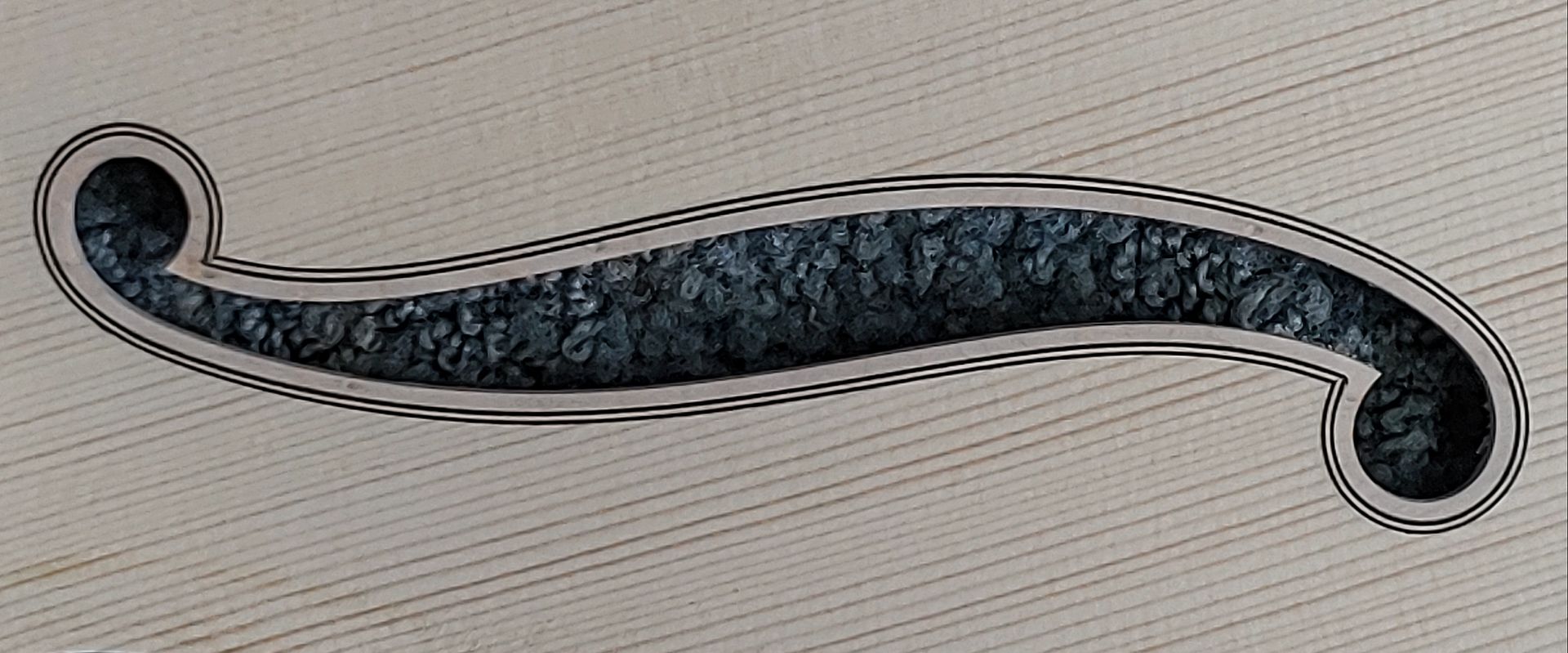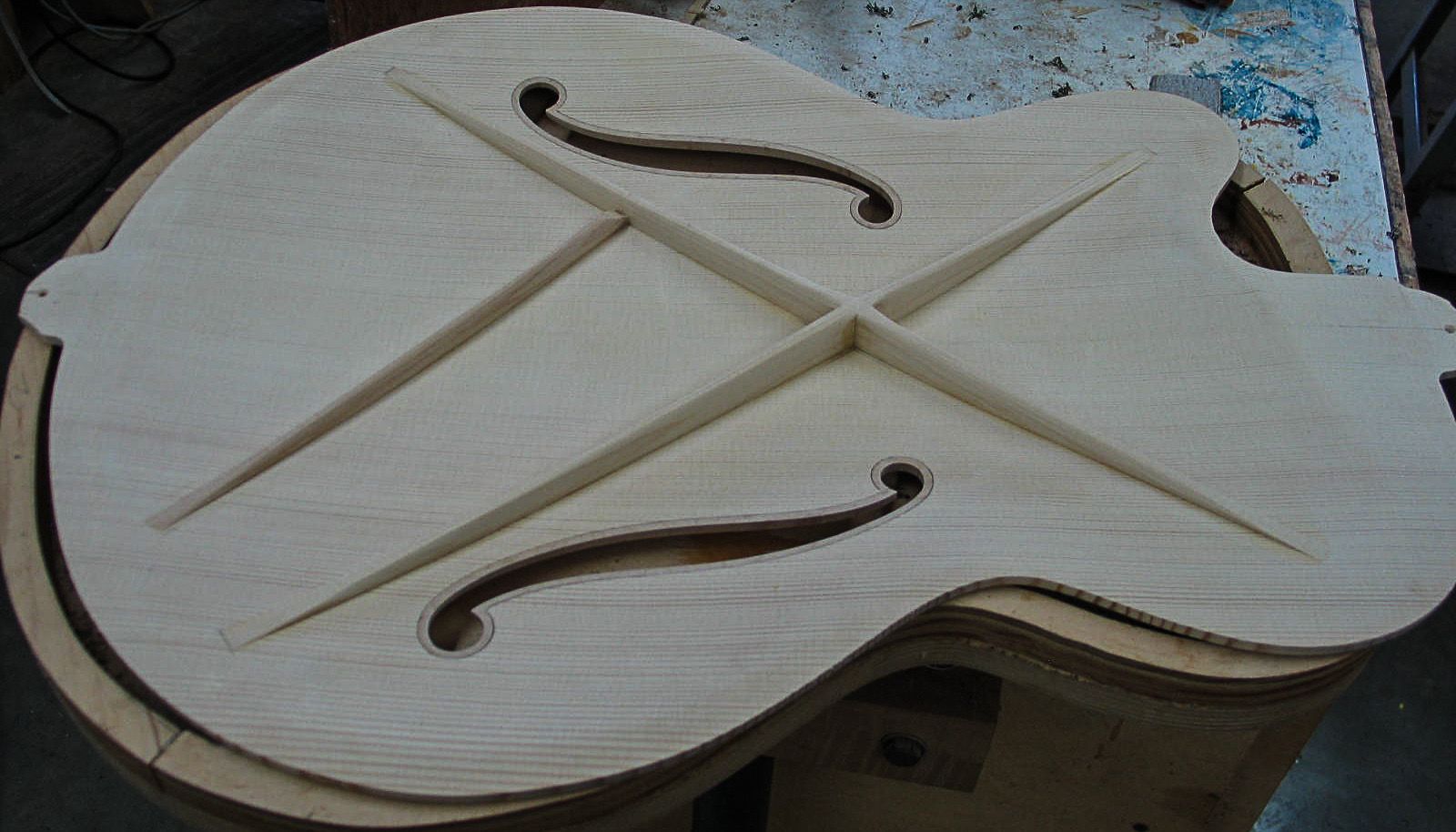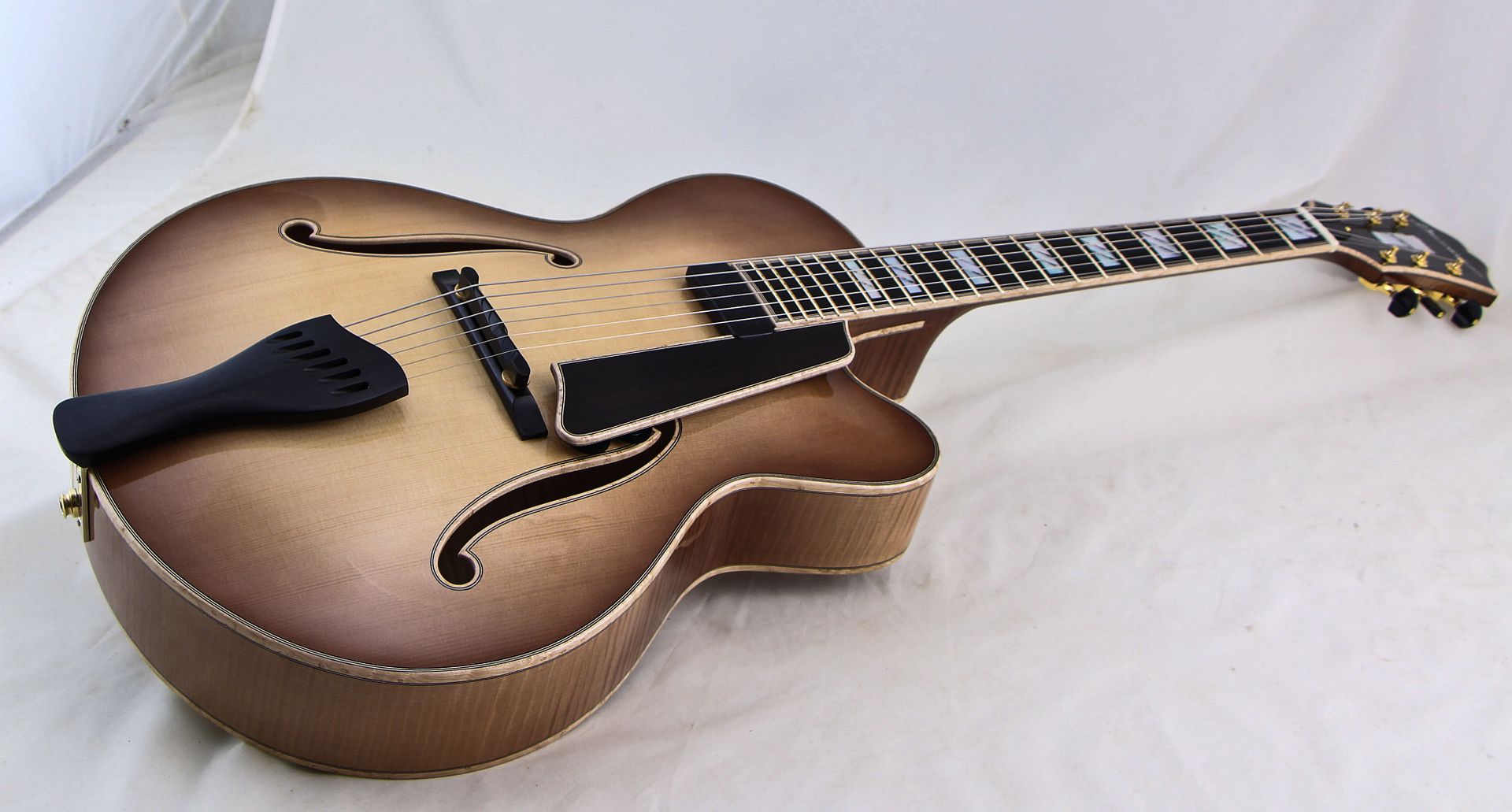-
Recent close-ups of Campellone and Benedetto builds make me wonder, how much those incredibly beautiful F-hole bindings affect the sound of a carved archtop. They surely add hours and hours of building time and reflect in the final price. They may also help prevent top cracks. But you never see them in the violin family of instruments. Apologies if the topic has been covered before.
Last edited by Gitterbug; 01-10-2024 at 04:16 AM.
-
01-10-2024 03:52 AM
-
That's an interesting observation - I never thought about it before. Good violins have purfling around the top, but I've never seen any violin with purfling or other binding around the f holes. I haven't looked at many mandolins over the years, but I don't remember seeing binding on their f holes either. I've seen a few articles saying that binding the f holes on a violin was thought to damp vibration of the top, but this doesn't seem to be the prevailing thought for guitars.
 Originally Posted by Gitterbug
Originally Posted by Gitterbug
-
There was a school of thought that developed at one point when some luthiers were eliminating as much plastic as they could from their guitars that more wood was better than adding plastic and were leaving f holes unbound and using wood bindings instead. D'Aquisto and John Zeidler immediately come to mind, though John always hated it on f holes from an aesthetic standpoint, I don't think he ever bound them on his archtops.
I suppose it could be valid from a sonic perspective but I'm guessing only a dog could discern a difference.
btw you can blame Gibson and Epiphone for the initial binding craze. Gibson was looking to snaz up their archtops once the 30s came around and as usual Epiphone and D'Angelico followed suit to keep up w the Joneses.
-
It's always been an achielles heel of soft woods (conifers used for tops) that exposure to air in the end grain will cause splits along the grain. This is the bane of luthiers even when the wood is fresh cut; invisible checks can cause seam splits and top cracks even undetected at the time of the build.
From the first classical guitars this was an issue that was addressed through bindings and rosettes around the sound hole.
Not so much in the violin family because the manner of playing a violin (under the chin and the only points of contact being the lower bout against the chin and shoulder) so end grain wear is minimal, and protected by hard varnish.
Early archtops were a hybrid of violin (carved plates and tuned body with F holes), and guitar (purflings, bindings and bound fingerboards). This was where the practices became traditions perpetuated for practical as well as aesthetic reasons.
Guitars take a lot more wear and tear from being played as they are so bindings were essential. I've seen early Benedettos with violin type plates, and it makes sense because it extends the vibrating plate to and beyond the ribs, but I'd assume practical issues precluded that practice.
Bound F holes on solid top guitars serve a grain exposure protection...but they look nice too. Wood bindings can be made and they work really nicely. In general, open grain on solid carved tops is avoided. On late "art era" D'Aquistos, Jimmy wanted to go for a purist's approach. He went for finished sound holes and dispensed with a bound end grain. But he was making art and I think he assumed those owners would take care not to wear down their end grain in every day gigging use.
-
The f holes on archtop guitars are much larger than those on violins
 . This exposes much more end grain surface area to moisture fluctuations, as well as the possibility of shock trauma, which can also cause splits. All this is just thought experiment, though, and I have no scientifically valid information on the subject. I have seen more photos of top splits around unbound f holes, and I don't actually remember ever seeing one with bound f holes. That's still just anecdotal information from a rather small sample size, though. I have a couple of Wu-built archtops with f holes bound with wood, and I like the look better than plastic. In general, I much prefer wood binding over plastic, but plastic is common, probably because it's much cheaper, easier to obtain in the proper sizes, and easier to bend and glue. It's also traditional, which is very important.
. This exposes much more end grain surface area to moisture fluctuations, as well as the possibility of shock trauma, which can also cause splits. All this is just thought experiment, though, and I have no scientifically valid information on the subject. I have seen more photos of top splits around unbound f holes, and I don't actually remember ever seeing one with bound f holes. That's still just anecdotal information from a rather small sample size, though. I have a couple of Wu-built archtops with f holes bound with wood, and I like the look better than plastic. In general, I much prefer wood binding over plastic, but plastic is common, probably because it's much cheaper, easier to obtain in the proper sizes, and easier to bend and glue. It's also traditional, which is very important.
-
How about cellos and basses?
 Originally Posted by sgosnell
Originally Posted by sgosnell

-
They're narrower for the given size. Plus, they're also not played in ways or treated in the ways guitarist expose them to.
 Originally Posted by Woody Sound
Originally Posted by Woody Sound
And, yes I've seen my share of grain splits on violin family instruments, originating from the F holes. They are not immune.
-
I agree that binding the F holes protects and seals the top much better. Guitar makers do not like binding because it is a lot more work. I happen to like binding but if it gets bad over the years and can lead to a pretty poor looking guitar at the edges. With the binding gassing out like it did on guitars made especially in the 1950's it because a turn off. I think the best approach might be wood bindings.
My late friend Bill Hollenbeck like the traditional f hole bindings but he went back to the violin style f-hole with the straight cut across the ends. This made for much more fussing to get the f holes bound. Frankly I like it but actually prefer the standard curved f hole found on L5's. They nice smooth symmetrical look is appealing. My favorite f holes though are the smaller ones found on the early D'angelico's in the 1930's. They look cool and to my ear sound better. Here is a picture of Hollenbeck's F holes and binding. Hard to tell but the f holes have 3 layers WBW. That is a huge amount of work.
-
Many unbound f-holes on carved archtop guitars have reinforcements on the undersides of the top plates. This can be small wood pads, muslin, or other materials. These vary considerably in size and shape, but their purpose is to prevent wood splits. This approach works great. IMO, f-hole binding is purely a cosmetic consideration.
IMO, binding stiffens the top plate at the f-holes, which affects the way the top vibrates in some manner. Whether that's good or not for the sound of an acoustic archtop guitar is a matter of personal preference. I'm unaware of any tests to establish the differences in sound - I suppose this would involve testing a guitar with unbound f-holes, then adding binding in a way that maintains the area of the openings as a constant, and re-testing.Last edited by Hammertone; 01-10-2024 at 04:32 PM.
-
Interesting question. Perhaps Mark Campellone will weigh in on this. I’ve wondered about the long-term possibility of splitting on unbound F-holes. I hope binding truly has no negative impact to the intended vibration of the top plate. Beyond the potential positive advantages to possibly prevent cracking/splitting, the sheer display of craftsmanship can be breathtaking.
I love the wood binding some luthiers have begun using. See the following example from a recent Wilkie instrument.
This is of particular interest to me because I’ve commissioned an acoustic archtop that has large unbound sound holes. Further, the luthier has “carved” the larger sound hole in a manner that further reduces the overall thickness of the plate around the sound holes. (Both of the instruments shown are by the same luthier.)
-
I have three vintage archtops, all D'Angelicos. Only one of the three has bound F holes. The other two have no issues and being from 1937 and 1948, I would opine that unbound F holes hold up just fine.
-
I’m like GB, give me that Creamy White stuff in the f holes with an oversized Ebony bridge.
-
Binding in violin family instruments is not traditional, therefore can't be used.


I think it's inevitable that some f holes will develop splits, and some won't, whether bound or unbound. And it's inevitable that some won't have splits, whether bound or unbound. I don't have enough reliable data to say whether binding prevents or causes splits, or has no effect. I do sometimes speculate, however. Binding does provide a nice cosmetic touch, regardless of any other effects.
-
The argument that the binding would prevent any moisture from seeping into the endgrain does not make much sense to me since it is such an easy feat for the builder to seal the edges with a simple coat of sealer/lacquer. The splitting of the top plate we see on so many older archtops is most often the result of carelessness, a bump onto the top and since the opening weakens the top in this area it does not require much force to cause a crack.
IMHO the fashion of binding comes from the century old tradition of dressing up instruments to make them more valuable, fashionable, representative and unique. Just take a look at the gaudy neapolitan mandolins, the parlor guitars of the 19th century or the more recent abominations coming from the custom shops of Martin and Gibson. There is a market for that stuff ... the craftsmanship is astounding, non-the-less !
James D'Aquisto began stripping away all that bling AFTER he thought that he was established well enough as an independent luthier, stepping away from these traditions and he established his own aesthetic, with good reason, too : the bling does nothing to augment the sound or playability of the instrument.
I love the looks of a 40's/50's sunburst D'Angelico New Yorker and I appreciate it as a piece of art and a testatment of the times and the spirit of the era that is was made in but the stark beauty of D'Aquisto's Avantgarde model has a charm and allure all of it's own.
-
Bob Benedetto also moved away from the bling as he became established. I don't know if it was just aesthetics or the need to produce instruments faster, maybe both. Eliminating fretboard inlays and f hole binding certainly can reduce the time required to get a guitar out the door, and if you can sell all you build without them, it makes life a lot easier.
-
Exactly what I always wanted to know but was "afraid" to ask

All violins *should* have purfling because it serves a function: stopping cracks that may start in the unprotected "overhang". Originally Posted by nevershouldhavesoldit
Originally Posted by nevershouldhavesoldit
F-holes have rounded ends which help prevent cracks from starting there. I can't remember if it's common to glue some tissue or canvas against the inside of the top when cutting them out. AFAIK none of my violins (still) had them but my Loar does.
I'd say it cannot not be the case. Even if you bind with material of the exact same density and keep the open surface constant you still have a discontinuity that's probably either not perfectly rigid (= absorbs energy) or is too rigid.I've seen a few articles saying that binding the f holes on a violin was thought to damp vibration of the top, but this doesn't seem to be the prevailing thought for guitars.
If so that must be the case on guitars too, never mind the fact that the excitation of the top is very different from what it is in bowed instruments. The question is whether you'll notice it - or whether anyone cares because of the sad fact that most of these instruments are destined to speak through a pickup anyway...
-
I think you were thinking about cats (the musical species ^^). Dogs might be able to smell the difference though
 Originally Posted by wintermoon
Originally Posted by wintermoon

-
I doubt that your average f-hole binding has any significant impact on the sound of the guitar. And yes, it may help prevent the development of cracks, though as HT mentioned, this can also be done effectively on the inside of the top using something as unobtrusive as fabric - seen this on some old Gibsons.
 Originally Posted by AKA
Originally Posted by AKA
Btw, on that Wilkie with the odd shaped f-holes, is that a one piece top?
-
With reference to guitar bindings in general, I like plastic (non-celluloid) - while bindings definitely dress up a guitar, I believe the primary function is protection. Guitars get a lot of body contact and lacquer can wear off relatively quickly on corners. With plastic bindings, even if the finish wears off, you still have an impervious material that won't absorb sweat and body oils.
 Originally Posted by gitman
Originally Posted by gitman
-
Here are some Birdseye Sugar Maple bound and purfled f-holes that John Buscarino executed in my 16” Monarch archtop. I thought someof you might want to see them from the inside of the carved top plate.


Here they are in the finished instrument. Using Birdseye Sugar Maple is not traditional, but I prefer it to ABS.

-
Hmm.. Thinking unbound F holes aren't necessarily exposed-to-the-air wood grain ends. Inside of bare naked F holes on my Gibson L5 Studio (solid spruce) and ES175 (laminate) are either stained or painted or both. My nicer guitars like the Yunzhi's and Wu's are all wood bound. Thinking that's strictly aesthetics to go with wood bindings on the rest of the guitar without regard for durability.
-
I have two 40’s triumphs with zero splits (knock on….wood?). Epiphone luthiers added some reinforcement as described above.
-
It used to irk me that the f holes in my L4 CES were unbound.
They are painted black though and I’ve come to appreciate the clean look.
A word of caution though; when I first started on violin, I had a Hofner model with a delicate varnish. The polishing cloth caught the edge of one of the f holes and tore a piece of the finish off the top.
Needless to say I’m very careful of this when cleaning my unbound f hole guitars. Lesson learned.
-
having played violin in the past I can add this- as a violinist ( or cellist, viola, dbass player ) your hands are never brushing near f holes. -with possibly of pizzicato over the fingerboard being the worst of it. The archtop however has nasty snag points in the f holes that shirt sleeves and cuffs, etc can grab.
 Originally Posted by MCampellone
Originally Posted by MCampellone
On my violin the weakest part of the f is actually tapered lower than the general plane of the rest of the instrument somewhat protecting it from snagging. My Eastman on the other hand (bound) has the whole edge of the f hole co-planar with the top plate. I have witnessed 2nd hand vintage Archie’s with the edge of the inside hook chipped or snapped off. Sometimes reattached less than convincingly. Binding if nothing else provides strength to the fragile piece. If you see images of early mandolins and archtops I can understand why the bling became historical necessity. The same question can be applied to bound headstocks. Serves no purpose other than aesthetics and to hide/ protect from the inevitable dings?
-
Here’s a photo Wyatt Wilkie recently posted of some of his work. It’s hard to deny how nice that looks.

Sent from my iPhone using Tapatalk




 Reply With Quote
Reply With Quote



Moon River
Today, 02:05 PM in The Songs